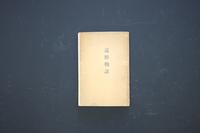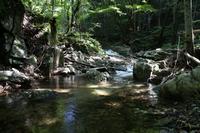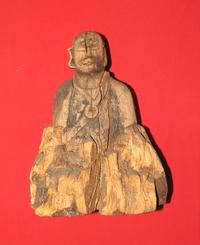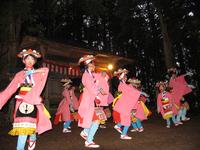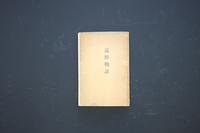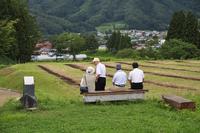重要文化的景観「遠野土淵山口集落」の見どころをご紹介します(多言語対応)
重要文化的景観「遠野土淵山口集落」のご案内
(1)馬産地・遠野と山口集落
馬は戦いや移動、運搬、農耕等に役立つ大事な動物で、遠野一帯でも古くから飼養されていました。江戸時代には南部藩の奨励により馬産の礎が築かれ、近代以降も基幹産業として営まれてきました。現在も、乗用馬や競走馬の育成が行われています。
山口集落は、江戸時代には山口村と栃内村という農村でした。明治時代に周辺の村と共に土淵村となり、昭和29(1954)年の合併で遠野市となります。遠野城下を引き継ぐ市の中心市街地から東方の三陸海岸へと向かう街道が通過しており、大槌方面と釜石方面に分かれて山道へと変わる分岐点に立地しています。沿道に並ぶ家々では、かつては馬を買い、農耕や駄賃付け(運送業)に利用していました。以上より本地区は馬産地・遠野を象徴する重要文化的景観「遠野 荒川高原牧場 土淵山口集落」の一部となっています。
(2)柳田國男『遠野物語』と山口集落
かつて人馬が行き交った山口集落では、目新しい話、珍しい話、不思議な話など、旅人によって様々な話がもたらされました。これと合わせて、家々や地域の由緒や伝承なども語られたものと思われます。こうして当地に残った話を収集していた佐々木喜善(1886~1933)が柳田國男(1875~1962)に語り、まとめられたのが日本民俗学の記念碑的著作とも言われる『遠野物語』です。
山口集落には、『遠野物語』に描かれる様々な場所や建物が随所に残っています。山男山女に出会うとされた界木峠や河童が出る姥子淵、ザシキワラシがいたという屋敷跡、60歳をこえた人が追いやられたデンデラノなどは、その一例です。人が馬と一緒に暮らしていたころ、山々への畏怖、危険な場所や物への警告、不思議な出来事、貧しい生活の悲しみなどをどのように表現してきたのかを、物語と景観で感じてください。
(3)山口集落のながめづくり
山口集落では、東には美しい山容を仰ぎ、西に豊かな農地を眺め、水がせせらぐ美しい景観を守り、現代の物語を書き込むために、住民自らが取り組む景観保全の指針として「おらほのながめづくりガイドライン」を定めています。また、遠野市と「遠野市土淵町山口集落ながめづくり協定」を結び、協働で『遠野物語』の原風景を守っています。
令和2年3月 遠野市教育委員会 協力 山口自治会
この事業は文化庁の補助を受けています
(1)Horse-rearing, Tono and the Yamaguchi Settlements
Horses are important and useful animals for battles, travel, transport and farming and have been bred for a long time in Tono. The foundations for horse breeding here were laid under the influence of the Nanbu Clan in the Edo era and it has been a core industry here since the modern period in Japan. In the present day also, horse-riding and breeding of race horses goes on in Japan.
The Yamaguchi Settlements were the rural villages of Yamaguchi and Tochinai in the Edo era. Joining with surrounding villages in the Meiji era, theYamaguchi Settlements were then in Tsuchibuchi Village and they became part of Tono City in 1954 which was formed by the merger of more villages. The road that runs east to the Sanriku Coast from the city center of the castle town of Tono splits into a road heading to Otsuchi and one heading to Kamaishi and changes to a mountain road at a junction located here. In the houses that lined the road here, horses were bred and used for farming and the packhorse industry (transportation by horses). As a result, this area became part of the important cultural landscape of Tono, Arakawa Plateau Ranch and the Tsuchibuchi Yamaguchi Settlements which symbolizes Tono and its horse-rearing industry.
(2)Kunio Yanagita’s The Legends of Tono and the Yamaguchi Settlements
Various tales were brought by travelers to the Yamaguchi Settlements where men and horses came and went including novel, unusual and strange ones. Together with these traveler’s tales, the history and traditions of the houses and local community were also spoken of. Kizen Sasaki (1886-1933) collected the stories that endured in this area and told them to Kunio Yanagita (1875-1962) who summarized them in his monumental work of Japanese folklore, The Legends of Tono.
The various places and buildings depicted in The Legends of Tono remain throughout this area. Examples include the Sakaigi-toge Pass where people might have come across residents from adifferent world like the Yamaotoko (man) and Yamaonna (woman), the Obakobuchi Pool where the kappa (a mysterious waterside creature) appears, the ruins of a mansion where there was a Zashikiwarashi (protective god in the image of a child) and Denderano where people over 60 were banished to. Come and experience the tales and landscape here to see how the people of those times living alongside their horses expressed their fears of the mountains, warnings of dangerous places and objects, strange events and the sadness of a poor life.
(3)Creating the view of the Yamaguchi Settlements
The Oraho no (our) Nagame-zukuri (view creation) Guidelines have been established as the guiding principles for the landscape conservation work undertaken by the residents of the Yamaguchi settlements themselves. They have agreed the Tono, Tsuchibuchi and Yamaguchi Settlements Nagame-zukuri (view creation) Pact with Tono City to collaborate to protect the original landscape that was the setting for The Legends of Tono.
March 2020 Tono Board of Education in collaboration with the Yamaguchi Residents’ Association
This project is subsidized by the Agency for Cultural Affairs
(1)馬產地・遠野與山口村落
馬是在戰爭及出行、運輸、農耕等方面發揮作用的重要動物,遠野一帶也是自古以來就飼養了馬匹。江戶時代,在南部藩的獎勵下打下了生產馬的基礎,在近代以來也作為重要產業而得以了發展。如今,日本仍在培育騎乘馬及賽馬。
在江戶時代山口村落是被叫做山口村與櫪內村的農村。明治時代與周邊的村一起成為了土淵村,1954年經過合併成為了遠野市。從承襲了遠野城下町的市中心區往東面的三陸海岸方向有一條大道通過,山口村落位於這條大道分叉成大槌方向與釜石方向山路的分叉點上。沿著道路兩側的家家戶戶過去都養馬,並將馬用於農耕和運輸業。出於上述原因,本地區成為了象徵馬產地遠野的重要文化性景觀「遠野荒川高原牧場土淵山口村落」的一部分。
(2)柳田國男《遠野物語》與山口村落
曾經人來馬往的山口村落,由旅行者們帶來了新奇故事、稀罕故事以及不可思議故事等各種故事。與這些故事相結合,家家戶戶和當地的淵源及傳承等也被人們講述成了傳說。這些在當地流傳下來的傳說故事,都被佐佐木喜善(1886~1933)收集了起來,並講述給了柳田國男(1875~1962),由其匯總成了堪稱日本民俗學之紀念碑的著作——《遠野物語》。
《遠野物語》中描述的各種場所及建築物,至今仍存在於山口村落裡。例如,被認為會遇見山中男妖女妖的界木峠,有河童出沒的姥子淵,傳說曾住著座敷童子的舊宅遺址,超過60歲的老人被趕到蓮台野去,等等。請通過傳說故事和景觀,感受一下在人與馬共同生活的時代,人們對群山的敬畏、對危險場所及東西的警告、各種不可思議的事件以及貧困生活的悲哀等是如何表達出來的。
(3)山口村落的「眺望景觀建設」
山口村落的居民們作為開展景觀保全的指針,自己制定了《Oraho no Nagame-zukuri Guideline我們的眺望景觀建設指南》。此外,還與遠野市簽訂了《遠野市土淵町山口村落眺望景觀建設協定》,共同守護《遠野物語》的原始風景。
2020年3月遠野市教育委員會 協力 山口自治會
本事業獲得了日本文化廳的補助。
(1)Région productrice de chevaux – Tono et le hameau de Yamaguchi
Les chevaux sont des animaux essentiels aux batailles, aux déplacements, au transport ainsi qu’à l’agriculture. Ils ont été élevés depuis longtemps dans l’ensemble de la région de Tono. Les bases de l’industrie du cheval ont été établies sous l’impulsion du clan Nanbu à l’époque Edo, en faisant une industrie qui continue de nos jours à être un secteur clé.Au Japon,on élève toujours des chevaux aujourd’hui, notamment afin de les monter ou pour les courses équestres.
Le hameau de Yamaguchi faisait partie des villages agricoles de Yamaguchi et de Tochinai à l’époque Edo. Il a été regroupé avec d’autres villages alentours à l’époque Meiji pour former le village de Tsuchibuchi, avant de finalement intégrer la ville de Tono en 1954. Il est traversé par la route qui rejoint le centre-ville, où se trouvait autrefois la cité médiévale qui entourait le château, à la côté Sanriku qui se trouve à l’est, se situant ainsi à la jonction où les routes en direction de Otsuchi et de Kamaishi se séparent. Autrefois, tout au long de cette route, les habitants élevaient les chevaux pour leur servir à l’agriculture ou au transport de marchandises (activités du transport). C’est pour ces raisons que cette zone fait aujourd’hui partie du « Tono plateau Arakawa ranch Tsuchibuchi Yamaguchi village», un paysage culturel important, symbole de cette région productrice de chevaux ≪Tono ≫.
(2)Kunio Yanagita, les « Légendes de Tono » et le hameau de Yamaguchi
Dans le hameau de Yamaguchi, où hommes et chevaux circulaient autrefois, les voyageurs rapportaient diverses anecdotes, tels que des histoires originales, inhabituelles ou même mystérieuses. On pense qu’en plus de ces histoires, d’autres relatant les chroniques et les traditions de la région et des maisons qui s’y trouvaient étaient également échangées. Kizen Sasaki (1886 – 1933) a collecté les histoires qui perduraient dans cette région, et les a transmises à Kunio Yanagita (1875 – 1962), qui les a rassemblées dans ses « Légendes de Tono », qui sont considérées comme une œuvre monumentale chroniquant le folklore japonais.
Il reste encore un peu partout au hameau de Yamaguchi de nombreux lieux et bâtiments décrits dans les « Légendes de Tono ». Par exemple, le col Sakaigi où l’on pourrait rencontrer des Yamaotoko (mâle) et des Yamaonna (femelle) (êtres d’un autre monde), le canal Obako où il serait possible d’apercevoir des Kappa (créatures non identifiées habitant au bord de l’eau), les ruines d’une résidence où apparaitrait un Zashikiwarashi (enfant divin protecteur), Denderano où devaient vivre reclus les personnes de plus de 60 ans, etc. Veuillez y faire l’expérience des histoires et des paysages qui évoquent la manière dont les gens exprimaient leur crainte des montagnes, les mises en garde contre les choses et lieux dangereux qui y existaient, les étranges événements qui s’y produisaient, ou encore la tristesse qu’évoque la vie dans la pauvreté de cette époque où hommes et chevaux vivaient ensemble.
(3)« Entretien du paysage » du hameau de Yamaguchi
Dans le hameau de Yamaguchi, les habitants travaillent eux-mêmes à la préservation du paysage selon les consignes établies par leurs « Oraho no Nagame-zukuri Guideline (Nos Directives d’entretien du paysage) ». De plus, un « accord d’entretien du paysage de la ville de Tono et du hameau de Tsuchibuchi Yamaguchi » a été conclu avec la municipalité afin de coopérer à la préservation des paysages des « Légendes de Tono ».
Mars 2020, Commission scolaire de la ville de Tono, avec la collaboration de l’association des résidents de Yamaguchi
Cette activité est subventionnée par l’Agence pour les Affaires culturelles.
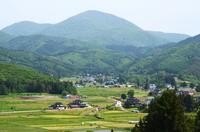
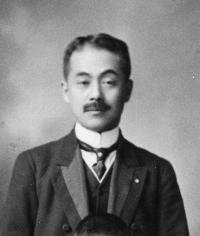
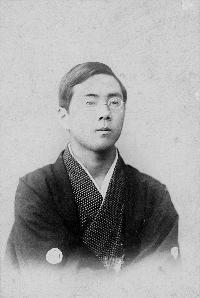
画像左から 六角牛山の眺め、柳田國男、佐々木喜善、『遠野物語』初版本
From the left image View of Mt. Rokkoshi Kunio Yanagita Kizen Sasaki The first edition of The Legends of Tono
圖像左起 從六角牛山的眺望景色 柳田國男 佐佐木喜善
À gauche de l’image Vue du mont Rokkoshi Kunio Yanagita Kizen Sasaki « Légendes de Tono », première édition
火石の石碑群
『遠野物語』序文に、「路傍に石塔の多きこと諸国その比を知らず」とあるとおり、遠野には多くの石碑がある。この火石の石碑群にも江戸、明治期の巡礼塔や馬頭観世音、庚申塔などの石碑が立ち並ぶ。なお、中央の石碑は「追分の碑」である。「右ハ於々川ち道 左ハ於不具尓道」と刻まれており、この場所が大槌街道と小国街道の分岐点であることを示している。
Stone Monuments of Hiishi
There are many stone monuments in Tono as reflected in the preface of The Legends of Tono where it states that “There were more tombstones alongside the roadside than I had seen in other areas.”Amongst the Stone Monuments of Hiishi, there are stone monuments of the Edo and Meiji eras including a Junreito stone monument marking a pilgrimage, a Batokanzeon monument to the god who protects horses and in memory of the dead, and a Koshinto monument in which the god of Koshin is enshrined.The center Oiwake no Hi (monument marking a forked road) is inscribed “Otsuchi Road is right, Oguni Road is left” indicating this was the location for the crossroads of the old Otsuchi and Oguni roads.
火石的石碑群
正如《遠野物語》的序言所寫道的「路旁有許多石塔,比我在其他地方見過的都要多」那樣,遠野有許多石碑。在這個火石的石碑群裡,就有明治時期的巡禮塔、馬頭觀世音和庚申塔等等,石碑林立。中央的那塊石碑叫做「追分之碑」。碑上刻著「右為大槌道,左為小國道」的字樣,表示這個地點是大槌大道與小國大道的分叉點。
Ensemble de stèles de Hiishi
Comme l’indique la description : « Je n’ai jamais entendu parler dans une autre préfecture d’un bord de route sur lequel on comptait autant de stèles », dans la préface des « Légendes de Tono », on trouve à Tono un grand nombre de stèles.On peut voir alignés dans l’ensemble de stèles de Hiishi différents types de stèles datant de l’époque Edo ou Meiji : Junreito (stèles commémorant un pèlerinage), Bato Kanzeon (édifice de pierre honorant la divinité protectrice de chevaux, stèle commémorative - y compris autre que pour les chevaux), stèles Koshinto dédiées au culte Koshin (érigées lorsque l’on réussit à 7 reprises à empêcher, en veillant à une date précise, que des vers s’échappent de notre corps pour aller prévenir le roi Enma des méfaits que l’on aurait commis ), etc.La stèle qui se trouve au centre est une « stèle debifurcation ». Il y est inscrit « route Otsuchi à droite, route Oguni à gauche », et son emplacement indique la séparation entre les routes Otsuchi et Oguni.
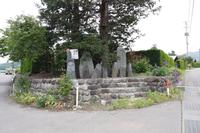
大槌街道
『遠野物語』第37話には、馬で荷物を輸送する駄賃付けが、大槌街道上にある界木峠で、たびたび狼に遭遇したという話が紹介されている。この街道は、近代になるまで駄賃付けを主とした、内陸部と沿岸部を結ぶ輸送の道で、情報や文化の行き交う街道であった。駄賃付けの賃金は、冬の夜間で3割増しにもなるが、積雪のために道がすっかり埋まり、命を落とす人も多かった。
Otsuchi Road
Chapter 37 of The Legends of Tono tells of how those who led packhorses to transport goods often encountered wolves at the Sakaigi-toge Pass on the Otsuchi Road. This road was mainly used by packhorses which were used for transporting goods between the inland and coastal areas until modern times. Information and culture would also be exchanged along this road.The fee for packhorses was 3 times the regular fee on winter nights. However, due to the road being completely buried in snow, many people lost their lives leading packhorses.
大槌大道
《遠野物語》第37節講述了趕馬運貨的人們常常在大槌大道的界木峠遇到狼的故事。這條大道在在近代之前是以運送貨物為主的,是連接內陸地區與沿岸地區的運輸幹線,也是資訊與文化往來繁多的一條大道。冬季的夜間運送貨物的費用會比平常漲價三成,因為積雪的緣故,路面完全被覆蓋,甚至有許多人因此而喪命。
Route Otsuchi
Le chapitre 37 des « Légendes de Tono » décrit l’histoire d’un transporteur de marchandises à cheval, qui rencontre régulièrement des loups dans le col de Sakaigi sur la route Otsuchi. Cette route était jusque récemment principalement utilisée pour le transport de marchandises à cheval. Reliant les régions côtières et intérieures, c’est une route qui favorisait les échanges d’informations et culturels.La rémunération de ces transporteurs de marchandises était triplée pour travailler les nuits d’hiver, mais la route se retrouvant complétement ensevelie sous la neige, beaucoup d’hommes y ont laissé la vie.
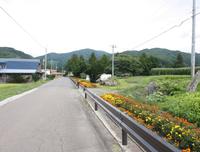
田尻の石碑群
中央にある馬頭観世音の碑には「右ハ山口 左ハ大槌」と刻まれている。この場所が、山口の街道と大槌街道の分岐点であることを示しており、かつてはこの場所が旧道であったことが分かる。一番左の青面金剛の碑には多数の人名が刻まれ、この中に、「孫左衛門」の名が確認できる。これは『遠野物語』第18話、ザシキワラシのいた家の当主である可能性がある。
Stone Monuments of Tajiri
“Right is Yamaguchi, left is Otsuchi” is inscribed on the Batokanzeon monument in the center. This indicates that this was the location of the crossroads of the Yamaguchi and Otsuchi roads and that the old road passed along here.Many people’s names are inscribed on the left-most Shomenkongo monument for the god who stops the insects at the time of Koshin. The name Magozaemon can be read amongst them. He may have been the head of the house where the Zashikiwarashi (protective god in the image of a child) was in chapter 18 of The Legends of Tono.
田尻的石碑群
中間的馬頭觀世音石碑上刻著「右去山口,左去大槌」。表示這個地點是山口的大道與大槌大道的分叉點,由此可知,這個地方曾經一條舊道。最左邊的青面金剛石碑上刻有許多人名,其中可以清晰辨認出「孫左衛門」這個名字。這個人有可能就是《遠野物語》第18節中說到的住有座敷童子的那戶人家的主人。
Ensemble de stèles de Tajiri
Il est inscrit sur la stèle Bato Kanzeon qui se trouve au centre de l’ensemble, « Yamaguchi à droite, Otsuchi à gauche ». Cela indique que cet emplacement est l’embranchement entre la route allant à Yamaguchi et la route Otsuchi, et également qu’il s’y trouvait autrefois une ancienne route.De nombreux noms sont gravés sur la stèle honorant Shomen Kongo (divinité qui tient à l’écart les vers lors du rituel Koshin) qui se trouve tout à gauche de l’ensemble, dont celui de « Magozaemon ». Il se pourrait qu’il s’agisse du chef de famille de la maison dans laquelle apparaissaient les Zashikiwarashi (enfants divins protecteurs), dans le chapitre 18 des « Légendes de Tono ».
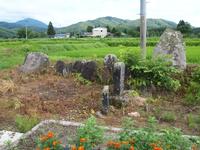
大洞家
『遠野物語』第69話には、この家の当主・大洞万之丞の養母おひでが魔法に優れ、まじないで蛇を殺したり、木に止まっている鳥を落としたりする話がある。この家の屋号は「大同」で、『遠野物語』に何度も登場する家柄であり、第83話には家の間取りが掲載されている。第69話、馬と娘の悲恋の物語「オシラサマ」を佐々木喜善に語ったのもこの家のおひでであった。
Ohora Residence
In chapter 69 of The Legends of Tono, there is a story about Ohide, the adoptive mother of Mannojo Ohora, the owner of the house. She excels at magic and can cast spells to kill snakes or drop birds perched in trees.The name of this household is Daido and this well-bred family appears many times in The Legends of Tono with chapter 83 describing the layout of the house. It was Ohide of this house that told Kizen Sasaki the Oshirasama story of disappointed love between a horse and a farmer’s daughter in chapter 69.
大洞家
《遠野物語》第69節中說到,有戶人家的主人名叫大洞萬之丞,其養母Ohide很擅長魔法,能用符咒殺死蛇,還能讓停在樹上的鳥掉下來。這戶人家叫做「大同」,是在《遠野物語》中多次出現的一個家族,在第83節中記載了這戶人家的房屋結構。第69節的馬與人類女子之間的悲劇愛情故事「蠶神」,就是這戶人家的Ohide老太太講給佐佐木喜善聽的。
Résidence Ohora
Le chapitre 69 des « Légendes de Tono » évoque Ohide, la mère adoptive de Mannojo Ohora, le chef de famille de sa maison, qui à l’aide de sortilèges tue des serpents ou fait tomber les oiseaux des arbres.Cette maison, dont la famille apparaît à maintes reprises dans les « Légendes de Tono », est appelée « Daido », et sa configuration est décrite dans le chapitre 83. C’est cette même Ohide qui a raconté à Kizen Sasaki l’histoire d’amour tragique d’un cheval et d’une jeune fille, titrée « Oshirasama », qu’on retrouve dans le chapitre 69.
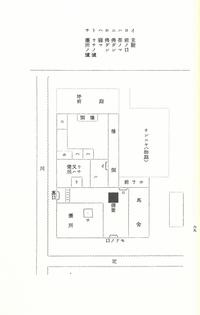
画像左から 『遠野物語』第83話に掲載されている大洞家の間取り、オシラサマ
From the left image The layout of Ohora Residence features in chapter 83 of The Legends of Tono Oshirasama
圖像左起 《遠野物語》第83節記載的大洞家的房屋結構 「蠶神」
À gauche de l’image Configuration de la résidence Ohora, décrite dans le chapitre 83 des « Légendes de Tono » « Oshirasama »
田尻家の怪異
『遠野物語』第77話には、田尻家は土淵村で一番の物持ちとある。第79話には田尻家の奉公人が、玄関の雲壁に張りついて首を垂らし、目玉を突き出した男に遭遇する話が紹介されている。第82話では、田尻家の人が家の中で知らない人と遭遇し触ろうとしても触れない話もある。柳田國男はこの怪異の話者について、近代的で利口な人、嘘を言う人ではない、と締めくくっている。
Phantom of the Tajiri Family
The Tajiri family is said to be the wealthiest in Tsuchibuchi in chapter 77 of The Legends of Tono. Chapter 79 introduces a story where a servant of the Tajiri family encounters a man clinging to the wall above the entrance with his head hanging down and his eyeballs sticking out. There is also a story in chapter 82 where a Tajiri family member encounters an unknown person and tries to touch them but is unable to.Yanagita concluded that the person who told of the phantom was modern, clever and not a liar.
田尻家的怪異
在《遠野物語》第77節中說到,田尻家是土淵村的首富。在第79節中講述了田尻家的傭人遇到一個緊貼在玄關的雲壁(玄關上的牆壁)上低著頭眼珠突出的男人的故事。在第82節中也說到,田尻家的人在家裡遇到一個陌生人,想去摸一下但卻摸不到。柳田最後總結說,講述這些奇異故事的人,是近代的一個很聰明的人,不是一個會說謊的人。
Le mystère de la famille Tajiri
La famille Tajiri, qui est évoquée dans le chapitre 77 des « Légendes de Tono », était la plus riche du village de Tsuchibuchi. Le chapitre 79 présente l’histoire d’un domestique de la famille Tajiri qui tombe nez à nez avec un homme suspendu par le cou au mur surplombant l’entrée de la maison, ses yeux sortant de leurs orbites. Dans le chapitre 82, un des membres de la famille Tajiri se retrouve face à un inconnu dans la maison, mais lorsqu’il essaye de le toucher ce dernier s’avère intangible.Yanagita conclut en expliquant que la personne ayant rapporté ces mystères est quelqu’un de moderne et intelligent, qui n’est pas du genre à mentir.
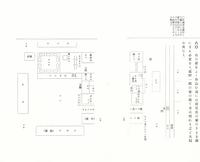
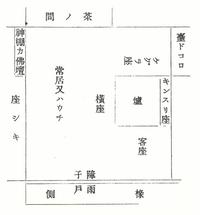
画像左から 『遠野物語』第80話に掲載されている田尻家の間取り
From the left image The layout of Tajiri Residence features in chapter 80 of The Legends of Tono
圖像左起 《遠野物語》第80節記載的田尻家的房屋結構
À gauche de l’image Configuration de la résidence Tajiri, décrite dans le chapitre 80 des « Légendes de Tono »
河童淵(姥子淵)
山口集落には、古くから河童の話が伝わる。『遠野物語』の第58話では、ここにいた河童が「新屋」という屋号の家の馬を川に引きずりこもうとしたが、逆に馬の力に負けて馬屋まで引っ張られて家まで来てしまった話が紹介されている。村人たちが集まり殺すか許すか評議し、結局今後いたずらしないことを固く約束し、逃がしてやった。河童は村を去り、この上流にある相沢の滝に移ったという。
Kappabuchi Pool (Obakobuchi)
The story of the kappa (a mysterious waterside creature) has passed down the generations in the Yamaguchi Settlements since long ago. Chapter 58 of The Legends of Tono tells of a story where a kappa tried to drag a horse belonging to the household of Shinya into a river but instead lost out to the power of the horse and was itself dragged to the stable and then as far as the house.The villagers gathered and discussed whether to kill or forgive the kappa. In the end, the kappa firmly promised to do no more mischief and was set free. It left the village and moved to Aisawa Falls upstream of the village.
河童淵(姥子淵)
在山口村落,自古以來就流傳著有關河童的傳說。《遠野物語》的第58節講述的就是一個河童想把叫做「新屋」這戶人家的馬拉進河裡,但是力氣不夠,反被馬拉到了馬廄前,來到了這戶人家裡。村民們紛紛趕來,商量著是殺了這個河童還是放了它,最後讓河童許諾今後絕不再戲弄村裡的馬,然後把它放走了。據說這個河童離開了村子,改住到了上游的相澤瀑布那裡。
Canal Kappabuchi (canal Obakobuchi)
Depuis des temps anciens, des histoires de Kappa (créature non identifiée habitant au bord de l’eau) se transmettent dans le hameau de Yamaguchi. Le chapitre 58 des « Légendes de Tono » raconte l’histoire d’un Kappa qui tente d’entrainer dans la rivière le cheval d’une maison nommée « Shinya », mais face à la force du cheval c’est lui qui se fait trainer jusqu’à la maison par ce dernier.Les villageois se réunissent alors pour débattre s’il faut ou non le tuer, mais finalement ils décident de le laisser partir après qu’il ait promis de ne plus jouer de tour à l’avenir. Le Kappa quitte le village et s’installe dans la cascade d’Aisawa qui se trouve plus en amont.
相沢の滝 Aisawa Falls 相澤瀑布 d’Aisawa qui
孫左衛門の屋敷跡
『遠野物語』第18話には、この家に童女の神(ザシキワラシ)が二人いる、と紹介されている。孫左衛門は村の旧家で、20人もの雇人がいるほど栄えていた。ある年、この二人が家から出ていったのを村人が目撃した。ほどなくして、家の者はキノコの毒にあたり、遊びに出ていた家娘一人を残し、みんな死んでしまった。ザシキワラシのいる家は栄え、出ていくと没落するという。今は井戸と墓のみが残る。
Remains of the Magozaemon Residence
Chapter 18 of The Legends of Tono states that there are two gods in the image of children (Zashikiwarashi) in this house. Magozaemon was an old house of the village that prospered to the point of employing 20 people. One year, a villager witnessed the two Zashikiwarashi leave the house. A short while later, all of the people of the house except one of the daughters who had gone out were poisoned by mushrooms and died. It is said that a house where a Zashikiwarashi resides prospers but falls to ruin when it leaves. Only a well and tombstones remain of the old house these days.
孫左衛門的舊宅遺址
《遠野物語》第18節講述了有一戶人家裡有兩個女童模樣的神仙「座敷童子」。孫左衛門是村子裡的世家,曾有過20個傭人,榮盛一時。有一年,村裡有人看到這兩個女童從孫左衛門家出來,走掉了。不久後,孫左衛門家裡的人吃了有毒的蘑菇,全都死了,只剩下一個當時出外遊玩的小女孩倖免遇難。據說,有座敷童子的家族會很榮盛,而如果座敷童子離開,這個家族就會沒落。現在孫左衛門家只剩下了水井和墳墓。
Les ruines de la résidence de Magozaemon
Le chapitre 18 des « Légendes de Tono » décrit la présence de l’esprit de deux enfants (Zashikiwarashi) dans cette maison. La famille de Magozaemon était une ancienne famille du village, très prospère avec plus de 20 employés à son service. Une année, les villageois ont aperçu ces deux esprits sortir de la maison. Peu de temps après, l’ensemble de la famille, à l’exception d’une fille sortie s’amuser, trépassa à cause de champignons empoisonnés. Les maisons dans lesquelles résident des Zashikiwarashi prospèrent, et lorsqu’ils s’en vont cela annonce le déclin de celle-ci. Aujourd’hui il ne reste de la résidence qu’un puit et des tombes.
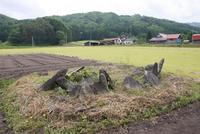
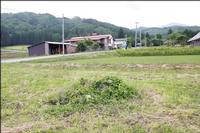
画像左から 孫左衛門家の墓と井戸、孫左衛門家の地蔵
From the left image Tombstones and a Well of Magozaemon Residence Jizo of Magozaemon Residence
圖像左起 孫左衛門家的墳墓和水井 孫左衛門家的地藏菩薩 孫左衛門家的地藏菩薩
À gauche de l’image Tombes et puit de la résidence de Magozaemon Jizo de la résidence de Magozaemon
薬師堂
『遠野物語』第21話には、薬師堂のご利益について、堂守の話が紹介されている。堂内には薬師如来坐像のほか、十二神将像、鰐口などがある。入口の鰐口には集落で確認できる最古の貞享2年(1685)の刻銘があり、この社堂が江戸時代前期から存在することを示している。山口集落として唯一祀る社堂であり、お祭りが行われる毎年5月上旬には、山口さんさ踊りが奉納される。
Yakushido Temple
Chapter 21 of The Legends of Tono tells the story of the temple keeper telling of the benefits given by the Buddha of Yakushido Temple. In addition to the seated statue of Yakushi Nyorai (the healing Buddha) found in the temple, there are also images of the Twelve Divine Generals and a waniguchi gong hanging at the entrance. The inscription dated 1685 on the waniguchi gong is the oldest inscription in the Yamaguchi Settlements and indicates that the temple has existed here since the early Edo era.It is the only temple dedicated to the Yamaguchi Settlements and the Yamaguchi Sansa Dance is performed as an offering to the temple at the annual festival in early May.
藥師堂
《遠野物語》第21節講述了藥師堂的守殿人所說的關於藥師堂靈驗的故事。藥師堂內除了藥師如來坐像之外,還有十二神將像和鱷口等塑像。入口處的鱷口刻上有1685年的銘文,是山口村落有據可查的最古老的歷史記錄,由此可知,這座藥師堂在江戶時代前期就已經存在了。這是山口村落供奉的唯一一座寺院,每年5月上旬舉行例大祭的時候,都會在這裡跳山口三颯舞。
Pavillon Yakushido
Le chapitre 21 des « Légendes de Tono », qui décrit les avantages du pavillon Yakushido, présente l’histoire du gardien du pavillon. En plus d’une statue assise de Yakushi Nyorai, on trouve entre autres dans l’enceinte du pavillon des statues à l’effigie des douze généraux célestes ainsi que des gongs waniguchi. On peut voir sur le gong waniguchi à l’entrée du pavillon des inscriptions remontant à l’an 2 de l’ère Jokyo (l’an 1685), ce qui témoigne de l’existence de ce pavillon dès les prémices de l’époque Edo. C’est l’unique temple bouddhiste vénéré dans le hameau de Yamaguchi, et la danse Sansa de Yamaguchi lui est dédiée lors du grand festival annuel qui se tient début mai.
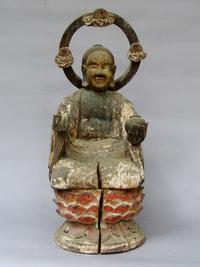
画像左から 薬師如来坐像、山口さんさ踊り
From the left image Yakushi Nyorai (the healing Buddha) Yamaguchi Sansa Dance
圖像左起 藥師如來坐像 山口三颯舞
À gauche de l’image Yakushi Nyorai danse Sansa de Yamaguchi
佐々木喜善の生家
『遠野物語』の話者・佐々木喜善の生家。喜善はこの家で家族から数々の民話を聞きながら育った。ザシキワラシに関する伝説を集めた著作『奥州のザシキワラシ』を出版し、『江刺郡昔話』では「昔話」という言葉を初めて使った。『遠野物語』の著者である柳田國男も喜善の家を訪れている。
Birthplace of Kizen Sasaki
This is the birthplace of Kizen Sasaki, the narrator of The Legends of Tono. Kizen grew up in this house listening to many folktales from his family.His publication was The Zashikiwarashi of Oshu which is a collection of legends about Zashikiwarashi (protective god in the image of a child) and he first used the word ‘mukashibanashi (old tales)’ in his book titled Old Tales of Esashi. Kunio Yanagita, the author of The Legends of Tono, also visited Kizen’s house.
佐佐木喜善出生之家
這是《遠野物語》的講述者佐佐木喜善的出生之家。佐佐木喜善在這個家裡出生長大,在家人那裡聽到了許許多多的民間故事。收集了各種座敷童子相關傳說的著作《奧州的座敷童子》出版,在《江刺郡昔話》中首次採用了「昔話(傳說故事)」這一詞。《遠野物語》的作者柳田國男也到訪過佐佐木喜善的家。
Maison de naissance de Kizen Sasaki
Il s’agit de la maison où est né Kizen Sasaki, le narrateur des « Légendes de Tono ». Kizen y a été élevé tout en écoutant les nombreux contes folkloriques que sa famille lui racontait.En tant qu’auteur, il a publié un recueil de légendes au sujet des Zashikiwarashi (enfants divins protecteurs), « Zashikiwarashi d’Oshu », et il a été le premier à utiliser le terme « mukashi-banashi » (contes et légendes traditionnels du Japon) dans les « Contes et légendes d’Esashi-gun ».Kunio Yanagita, l’auteur des « Légendes de Tono », a lui aussi visité la maison de Kizen.


画像左から 佐々木喜善の生家、佐々木喜善、『遠野物語』初版本
From the left image Birthplace of Kizen Sasaki Kizen Sasaki The first edition of The Legends of Tono
圖像左起 佐佐木喜善出生之家 佐佐木喜善 《遠野物語》初版版本
À gauche de l’image Maison de naissance de Kizen Sasaki Kizen Sasaki « Légendes de Tono », première édition
山口の水車小屋
この水車小屋は、長らく使われていなかったが平成27年(2015)度に修理し、実際に使える水車となった。車輪が小屋の中央にあり、ワラと豆類などを両方同時に打てる構造になっている。往時は、脱穀や製粉のため、昼も夜もゴトゴト音をたてて粉塵を噴き上げていた。
Yamaguchi Watermill
This watermill was unused for a long time but was repaired in 2015 and can now be used again. The wheel is located in the center of the shed and constructed in such a way that it can strike straw and beans at the same time.In the past, to do threshing and milling work the rumbling sound of the wheel could be heard day and night and dust would fly up into the air.
山口的水車小屋
這個水車小屋,很長時間沒有使用了,2015年進行修理後,已經變成了實際可使用的水車。水車輪設計在小屋的中央,兩邊可以同時打稻穀或豆類等。過去為了脫殼或製粉,不分晝夜都發出咕咚咕咚的聲音,粉塵飛揚。
Roue à aubes de Yamaguchi
Cette roue à aubes est restée inutilisée pendant de longues années, mais elle a été rénovée en 2015, et peut à nouveau être utilisée. La roue est située au centre d’une cabane, formant un système qui permet de battre simultanément des haricots et de la paille.Utilisée à l’époque pour le battage et la mouture, du bruit et de la poussière s’en échappaient jour comme nuit.
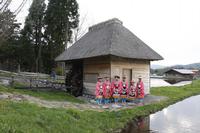
ダンノハナ
『遠野物語』第111話には、境の神をまつる小高い丘を「ダンノハナ」というと紹介されている。山口集落を見わたせるこの丘は、山口館の一部で、死者の冥福を祈る地とも、館があった時代の処刑場跡ともいわれている。現在は集落の共同墓地となっており、『遠野物語』の話者・佐々木喜善の墓がある。
Dannohana
Dannohana, which is a small hill in which a god that protects the village from evil spirits entering is enshrined, features in chapter 111 in The Legends of Tono. This hill, which offers a panoramic view of the Yamaguchi Settlements, is part of the old Yamaguchi Castle and is a site to pray for souls to rest in peace and is also said to be the remains of the place of execution of the old castle. It is now a communal cemetery for the village and the grave of Kizen Sasaki, the narrator of The Legends of Tono, is located here.
壇之塙
《遠野物語》第111節中介紹道,供奉境之神的小山丘叫做「壇之塙」。可以俯瞰山口村落全景的這座小山丘,據說曾是山口城的一部分,是為死者祈禱冥福的地方,也是當年山口城存在時用來處決囚犯的地方。如今這裡已經成為了山口村落的公共墓地,《遠野物語》的講述者佐佐木喜善的墓也在這裡。
Dannohana
Le chapitre 111 des « Légendes de Tono » évoquent « Dannohana » une petite colline dans laquelle réside la divinité Sakai-no-Kami, qui établit une démarcation shintoïste afin d’empêcher les mauvais esprits de pénétrer le village. Cette colline offrant une vue d’ensemble du hameau de Yamaguchi, était une partie du château Yamaguchi, et est considérée comme un lieu de prière pour les défunts ainsi que le lieu où on trouverait des traces du site où se tenaient les exécutions à l’époque du château.C’est de nos jours devenu le cimetière du hameau, où l’on y trouve la tombe de Kizen Sasaki, le narrateur des « Légendes de Tono ».
デンデラノ
『遠野物語』第111話には、デンデラノについて紹介されている。昔、60歳をこえた人はみんな、このデンデラノへ追いやる習わしがあったという。日中は里へ降りて農作をし、夕方になるとここに戻った。里へ降りることを「ハカダチ」、戻ることを「ハカアガリ」という話が残っている。
Denderano
Denderano features in chapter 111 of The Legends of Tono. Long ago it was the custom to send all people over the age of 60 to Denderano to die. In the daytime, they would go down to the village to work in the fields and then return to Denderano at night.The phrases ‘hakadachi (leaving the graves)’ for going down to the fields and ‘hakaagari (going to the graves)’ for returning home from the fields still endure.
蓮台野
《遠野物語》第111節中介紹了蓮台野。據說在過去有一種習俗,超過60歲的老人都要被趕到這個蓮台野去。白天到進到村子裡做農活,到了傍晚再回到蓮台野。因此,至今當地還習慣把進村幹活叫做「HakaDachi(出墓)」,把回家叫做「HakaAgari(回墓)」。
Denderano
Denderano est présenté dans le chapitre 111 des « Légendes de Tono ». La coutume voulait qu’autrefois, toutes les personnes qui atteignent l’âge de 60 ans étaient envoyés à « Denderano ». Ces personnes descendaient au village travailler dans les champs la journée, puis y retournaient le soir.Il persiste des histoires où sont utilisés les termes « Hakadachi » (quitter la tombe) pour descendre au village, et « Hakaagari » (grimper la tombe) pour le retour.
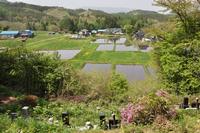

 印刷
印刷
